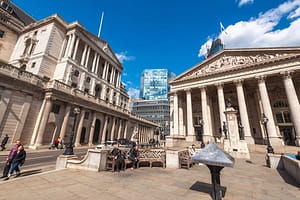Spotted those digital ads on top of taxis? This is the entrepreneur behind them
By now you will have noticed the new digital screens that sit on top of certain black cabs, allowing snazzy digital adverts to whizz around London town in a flurry of colour. You can expect to see many more of them in the near future because Piers Mummery, the entrepreneur and CEO behind the company behind this technology, is determined to capitalise on what he reckons is a £25m-£40m market opportunity.
Mummery launched BrightMove Media in December 2012, but it wasn’t until June 2013 that the first TaxiCast black cab wove its way through the streets of London. In the half-year since then, clients have including MasterCard, superstar shows Billy Elliot and MAMMA MIA!, Time Out and your very own LondonlovesBusiness.com.
Video:
BrightMove
Adverts can be cleverly geo-targeted, meaning different messages or ads appear according to what postcode the taxi is in, or change their message according to time of day for commuters or night owls.
It’s taken Mummery years of battling bureaucracy and rigorous health-and-safety testing to persuade Transport for London and the powers that be that digital adverts on top of taxis would not cause pedestrians to lose their concentration when walking and cause themselves calamities.
The six-person-strong BrightMove has a TaxiCast fleet of 25 at the moment, but he plans to increase that to 300 this year, with a target of 1,500 to 2,000 TaxiCast cabs within a few years’ time – around 10% of the total number of London black cabs.
Mummery is forecasting £1.5m turnover this year off, then £4.9m in year two, doubling to £9m by year three. And he should have a handle on forecasting by now, having launched two dozen companies in the last two decades – including the garden chain Shoots, although his background is largely sales and marketing.
We catch up with Mummery to find out more…
How did you go from running garden centres to this?
Taxi-top advertising has been around in America for about 20 years, so the idea was pretty obvious. It was one of those things where you think: why has it never been done?
Then [the co-directors and I] realised there were pretty big barriers to entry, both technological and regulatory. We thought it’s a challenge worth taking on. The timing was right with the digital opportunity, and it all just fell into place.
What were your first steps towards researching and building what is, let’s face it, quite a complicated product?
First we had to look at the regulatory landscapes and what we would need to do to get regulated by Transport for London. Then we had to understand the taxi community and understand their needs. Then the media landscape: who will want it? How will they buy? And we needed to understand the investment we would need to do to get it off the ground. It was very infrastructure-intensive to become an operational business and get all the equipment in place, and it’s required a huge amount of money to get off the ground.
You raised £680,000 seed investment – was that hard?
When it’s a good idea, it snowballs once you’ve got one person on board. And it’s actually a fairly straightforward business with a very big potential opportunity. But people buy into people and what you’ve created, so when we launched we had to do prototyping, to go through all those tests and put in all the legwork in.
How much have you raised to date?
I’d prefer not to publish numbers as we’re closing a round at the moment. But after that initial seed round to get the initial fleet out and the proof of concept done, on back of that we’re raising expansion capital to put another 125 taxis out in late spring. We will probably then need a further round.
What does the outdoor and taxi advertising landscape look like, in terms of competition and opportunity?
The UK advertising industry is worth about £16bn. Of that segment, the most obvious association [to what we’re doing] is out-of-home advertising [i.e. outdoor advertising], which is worth about £1bn.
What used to be paper-and-paste boards and ambient advertising is now becoming more and more digitised. That takes a huge change in terms of thought process in the industry. Planning and buying must be looked at in a very different way. […] Now with mobile and online and the data, you can target very, very specifically who and what advertisers want. That’s a big challenge to out-of home advertising. […]
The space where we sit is between digital and out-of-home [… and] we are a niche ourselves. But taxi advertising has been around for 40 years, which means it’s very proven. What we’re doing is the next generation of advertising within taxis, with more relevancy.
The market opportunity is quite substantial: focusing initially just in London, the [taxi-top advertising] market is probably worth £25-40m. That’s not based on our current fleet, but on one [that will become] probably 10% of the London taxi population: about 2,000 taxis.
But then you’ve got Liverpool, Manchester, Scotland, etc. And then whole international opportunity: the Middle East, the US, the Far East.

Tell about some of the regulatory difficulties you’ve had…
The biggest challenge has been that there has been no precedent [for taxi-top advertising] in the UK. As we were first to market, we’ve had to pave the way, so we’ve actually been working with TfL to set the precedent as to how they will regulate it.
[Editor’s note: There is a rival company called Eyetease that also offers taxi-top digital advertising, founded in 2010, although its technology differs in type of screen.]
Regulators are reactive rather than proactive, and there’s typically a lot of trial and error. You have to work out the key drivers from regulatory point of view. Fundamentally it comes down to safety, so it’s involved lots of electrical and electronic testing, testing of distraction levels [to make sure people won’t get too distracted and incur an injury if one of the taxi-top ads is passing by], testing of the engineering, installation, anything and everything you can think of! There’s no stone unturned – regulators are very, very detailed about compliance and doing things properly.
As you cross one hurdle, another one comes up. But you can’t give up – it’s been persistence for three years. You have to be sympathetic to [TfL’s] position, looking out for the safety of the public, although from an entrepreneur’s perspective it can be frustrating as you can only go at one speed.
Who do you see as your main competitors, and how will you beat them?
We’re first to market, and there are some very big barriers behind us that any operator behind us will hit. It’s not straightforward. The trick is to make things look simple. But actually going through that regulatory process is not for the fainthearted, and that will give us competitive edge – as will the knowledge you pick up in being first to market.
We have no direct competitors but there are plenty of threatening things: incumbent digital advertisers and billboards; [outdoor advertising companies like] CBS Outdoor and co. who have very entrenched relationships with media planners and buyer; other forms of advertising media, as we’ll pull traditional spend away from them. […] Also there will be indirect competition in a sense from budget pressure and what people actually want to spend on media.
You manufacture in Britain – why? Isn’t that more expensive?
It’s partly to do with scale – it doesn’t make sense to do it abroad as we’re not buying in tens of thousands of units. We have to custom make [our product].
We also have much greater quality control and general control, so in some ways it’s cheaper to build something in the UK [in terms of management].
But there’s also a pride thing saying you’ve built in Britain – that’s really nice. And this technology is a world-first for the UK.
Thanks for your time Piers.
Follow me on Twitter @sophiehobson and @londonlovesbiz
This article was updated on 30 January 2014 at 15:32pm.






Leave a Comment